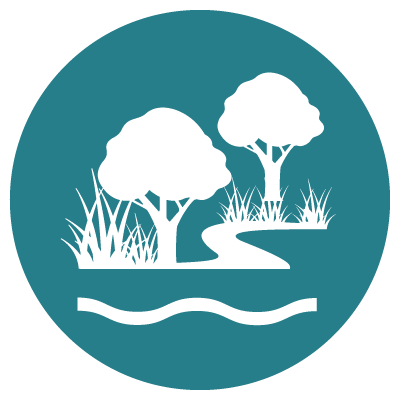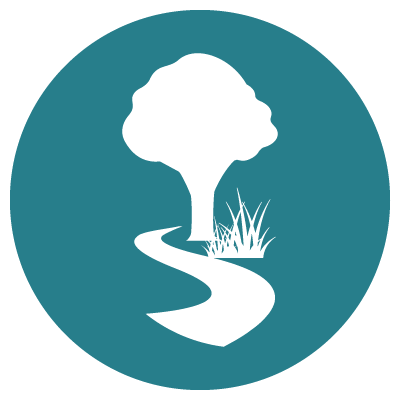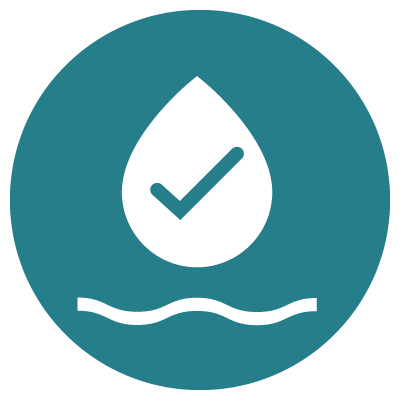Spotting platypus is always a thrill
Platypus are not only an iconic and unique native species, but also have a vital role in aquatic ecosystems as an apex predator. They mostly live in rivers, although they sometimes visit wetlands and estuaries.
The Millennium Drought had a significant impact on many platypus populations. Some, but not all populations have shown signs of recovery in the years since the drought ended.
In 2021, the Victorian Government formally listed the platypus population in Victoria as vulnerable.
Platypus populations are measured through live capture and eDNA surveys
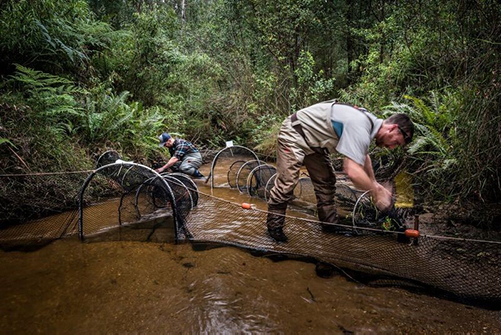
Platypus are naturally shy, so knowing how many live in a specific waterway is difficult to assess. To date, several different types of data are being used to provide information on platypus populations. Trapping and releasing platypus has been the main way to determine the abundance in different areas over time and this information is calculated as catch per unit effort (CPUE). Abundance of platypus as well as other measures of individual and population health such as sex, age, tail thickness and genetic diversity within and between populations is recorded. However, many factors can influence trapping efforts such as seasonal behaviour movement, environmental conditions, and placement of traps.
An emerging and complementary monitoring method for platypus is the use of environmental DNA (eDNA). Small traces of DNA from animals in the water (e.g. hair, scales, mucous, faeces, skin), can be analysed from water samples to identify species that are present, including a broad estimate of their abundance. Whilst eDNA has many advantages, it won’t completely replace the need for traditional live capture surveys.
Platypus sighting data is also recorded utilising the citizen science platform PlatypusSPOT.
Locations where platypus have been detected: 1995-2019
Live trapped eDNA detected
Trends in Platypus populations
Based on all the available data on catch rate, population genetics, distribution, and habitat connectivity, 10 distinct platypus populations have been identified in Melbourne’s catchments – Werribee Gorge, Lower Werribee, Jacksons Creek, Upper Deep Creek, Yarra River, Olinda Creek, Monbulk Creek, Cardinia Creek, Tarago/Bunyip Rivers, and Lang Lang River.
Most of the data depicted in graphs below was captured between 2006 and 2018. Older data dating back to 1996 will be added soon and was used in the interpretation of findings presented below.
The rating categories of Very high to Very low represent relative abundance. The thresholds are not reflective of population health measures or probability of occurrence (i.e. habitat suitability modelling outputs).
Hover, click or tap (on mobile) the charts below to view more information.
There are two distinct populations of platypus in the Werribee catchment; the Werribee Gorge and the Lower Werribee.
Werribee Gorge population
Platypus are currently found in the middle reaches of the Werribee River from the township of Ballan to the Bacchus Marsh diversion weir at the downstream end of Werribee Gorge. Intermittent flows in the upper Werribee River probably prevent permanent residence upstream of Ballan and in the upper Lerderderg River.
Anecdotal reports from local residents indicate a bigger population may have existed prior to the Millennium Drought. Several platypus sightings have recently been reported in the Bacchus Marsh area.
Very few platypus have been caught either in Ballan or through Bacchus Marsh (including the lower Lerderderg River) indicating only a few individuals likely remain in this stretch of river. This population is isolated from the lower Werribee River by poor habitat and flows and the Melton Reservoir, which is a significant barrier.
Lower Werribee population
Platypus currently occur throughout the lower Werribee River from Melton Reservoir to the estuary, likely including the lower reaches of Davis and Toolern Creeks. There is no evidence of platypus in the geographically separated Lollypop Creek or Little River. Occasional sightings outside of this area (i.e. Little River) probably represent misidentification with rakali or a transient platypus.
Long-term live-trapping surveys in the lower Werribee River show a significant decline in catch over time and the current number of platypus is considered to be very low. The genetic health of this population is poor with low genetic diversity due to its isolation and small population size.
There are two distinct populations of platypus in the Maribyrnong River catchment; Upper Deep Creek and Jacksons Creek.
Upper Deep Creek population
Despite the lack of consistent flows in the waterway, very low numbers of platypus persist in upper Deep Creek around Romsey and Lancefield. Further downstream around Darraweit Guim, platypus once occurred in moderate abundance but declined rapidly during the Millennium Drought and now could be locally extinct. No platypus have been recorded in the middle reaches of Deep Creek which is likely due to poor habitat quality and extended dry periods. It’s likely that platypus in upper Deep Creek are isolated from the Jacksons Creek population approximately 50 km away.
Due to the low numbers of individuals and difficult access conditions in the Upper Deep Creek catchment live trapping data is very limited and as such there are no graphs over time. Ongoing monitoring will largely be conducted using eDNA samples.
Jacksons Creek population
Data from live-trapping, eDNA surveys, and public sightings indicate platypus currently occur throughout Jacksons Creek, lower Deep Creek, lower Emu Creek and the upper Maribyrnong River as far downstream as Organ Pipes National Park.
Lower Jacksons Creek just downstream of Sunbury appears to support a core resilient population. Live-trapping surveys in lower Jacksons Creek recorded a significant decline in CPUE during the Millennium Drought however, the population recovered strongly after the drought broke, presumably due to the presence of refuge areas along the creek.
There are two distinct populations of platypus in the Yarra River catchment; Yarra River and Olinda Creek. The majority of platypus are found along the main stem of the Yarra River and its tributaries. Platypus in Olinda Creek have recently been confirmed by genetic analysis as a separate population, isolated from the Yarra population by the weir in Lilydale Lake and poor habitat in the lower reaches of the creek between the lake and the Yarra River.
Yarra River Population
Platypus are currently widely distributed throughout the Yarra River and most tributaries upstream of the confluence with Plenty River. There has been a gradual contraction in distribution from the western and northern parts of the catchment.
The upper Yarra catchment has the best platypus habitat in the region because there are many interconnected waterways with good water quality, reliable flow regimes and areas of forest in the upper reaches. Accordingly, data indicate the upper Yarra River and tributaries such as McMahon’s, Big Pat’s, Chum and Woori Yallock Creeks support the greatest number of healthy platypus.
A healthy population of platypus once existed in the upper reaches of the Plenty River in Toorourrong Reservoir and in upstream tributaries (data not shown). Over the last 15 years this population has declined dramatically to the point where it may now be locally extinct, although an unconfirmed sighting has recently been reported.
The catch rate of platypus has also declined significantly in the Diamond Creek through Eltham and small populations in its upper tributaries of Running Creek and Arthurs Creek have disappeared. In contrast, long term surveys in the nearby Mullum Mullum Creek report a relatively stable population over the same period.
Diamond Creek platypus populations have declined significantly over time while Mullum Mullum Creek populations have remained stable.
Platypus were once common in the lower Yarra River and tributaries, but few records of them exist after the 1960’s (data not shown). It’s likely that populations were impacted by urban development that occurred over this period.
Olinda Creek population
A small platypus population persists in upper Olinda Creek from the headwaters in the Dandenong Ranges National Park down to Lilydale Lake in Lilydale. The upper reaches are forested and retain a well-vegetated waterway corridor along most of the creek, despite it becoming more urbanised closer to the lake.
Consistent environmental flows from Silvan Reservoir (~3ML/day) is considered critical to the persistence of platypus in Olinda Creek.
Catch numbers in Olinda Creek have declined over the last 20 years although signs of recovery have been evident since the end of the Millennium Drought. Genetic analyses have confirmed this is a small isolated population.
Monbulk Creek supports the only remaining population of platypus in the Dandenong Creek catchment.
Monbulk Creek population
The platypus population in Monbulk Creek has been monitored regularly since 1996. Over this period, platypus have been caught from just above Belgrave Lake downstream to Kingston Links Golf Course on Corhanwarrabul Creek. Platypus were once present in the adjacent Ferny Creek but disappeared in the 1990’s.
Platypus numbers declined and their range contracted since 1996. They now favour the more upstream reaches of Monbulk Creek near Belgrave Lake where habitat quality is generally better.
The population is heavily male-biased (3.3 males :1 female) and aging, with many of the adults over 10 years old. Since the end of the Millennium Drought, some signs of recovery have been evident with the catch rate increasing a little and five juveniles have been captured. The population remains threatened by its isolation and low genetic diversity.
There are three distinct platypus populations in the Westernport Catchment; Cardinia Creek, Bunyip/Tarago River and Lang Lang River.
Cardinia Creek population
Platypus in Cardinia Creek disappeared from the system after the Ash Wednesday bushfires in 1983 but the population was almost certainly declining prior to this event. A trial reintroduction program was initiated in 2004 by Melbourne Water and the Australian Platypus Conservancy to re-establish a platypus population. Ten juvenile platypus (4 males, 6 females) were translocated from the Tarago River (9) and Olinda Creek (1) in several releases between 2004 and 2007.
The small population size, combined with the isolated nature of the system and limited habitat has raised concerns for the viability of this reintroduced population.
Bunyip/Tarago population
Platypus are currently distributed throughout the Tarago and Bunyip Rivers and associated tributaries with suitable habitat. The Tarago River appears to provide the best habitat and support the core population with the highest catch rate and evidence of reproduction. Platypus also extend through the middle and upper Bunyip River and adjoining tributaries (Cannibal, Diamond and Back Creeks), although habitat quality is considered poorer.
Populations appear in decline in the lower Tarago River and adjoining Labertouche Creek, although some increases are evident since the end of the Millenium Drought.
Recent genetic analyses indicate that the Tarago Reservoir may restrict movement and reproduction between upstream and downstream populations, although the extent of this differentiation is still being determined.
Platypus population size and range are thought to be limited by poor native streamside vegetation in the middle reaches of the Bunyip River and dense invasive willows. High sedimentation is also evident with large areas of clay or sand on the stream bed.
The lower Bunyip River is highly modified by channelisation and clearing of streamside vegetation. Limited surveys have been conducted in the lower reaches but platypus abundance appears to be low (data not shown).
Lang Lang River population
Platypus extend throughout the Lang Lang River where reliable permanent surface water is available.
The river upstream of the junction with Minnieburn Creek is seasonally dry and no platypus have been captured here, although individuals may occasionally use it when suitable flows are available.
Habitat quality is considered poor throughout the Lang Lang system and platypus abundance appears to be low and variable. No recent data is available for this system but new monitoring programs are planned.
Data available for download
Platypus health baseline and targets
2018 baseline: the condition of platypus was measured in 2018 using habitat suitability models developed using platypus data and a range of other region-wide data sets such as mean annual run-off and vegetation cover.
2068 target: the target represents where we want to be in 50 years and is what can be achieved with an increase in coordinated, collaborative and prioritised effort to address managing vegetation, urban stormwater and pollution, and water regime.
Without additional effort, the condition of existing platypus population across the majority of the region’s waterways are expected to decline as urbanisation and population growth continues and the climate becomes warmer and drier.
Even with the existing effort and resources of waterway managers, agencies and community, it will be extremely difficult to maintain all the waterway values everywhere. This knowledge provides a definitive call to action, and confirms that aligned, increased and collaborative efforts will be needed over the next 10 years.
Platypus populations will take some time to respond to environmental changes that are brought about by achieving the performance objectives. It may not be possible to detect improvements in platypus over the 10-year timeframe of the strategy. However, evaluation and reporting of platypus data will be undertaken to inform progress at mid-term and towards the end of the Healthy Waterways Strategy.
Habitat suitability models outcomes for the 2018 baseline and the long-term targets for each sub-catchment can be found on the Healthy Waterways Map. Monitoring sites can also be viewed on the map. For more information on the habitat suitability models and the monitoring program rationale see the Healthy Waterways Strategy Resource Document and the Rivers Monitoring and Evaluation Plan.
Number of waterways in each catchment by platypus score
Hover, click or tap (on mobile) the charts below to view more information.
Baseline and trajectories in Rivers
Conceptual models show the links between waterway conditions and platypus
Conceptual models are a summary diagram that illustrate which environmental conditions are most important for the health of platypus communities. In the diagram below they also show which conditions are most affected by climate change and urbanisation. Management actions that can improve environmental conditions are linked via box colours.
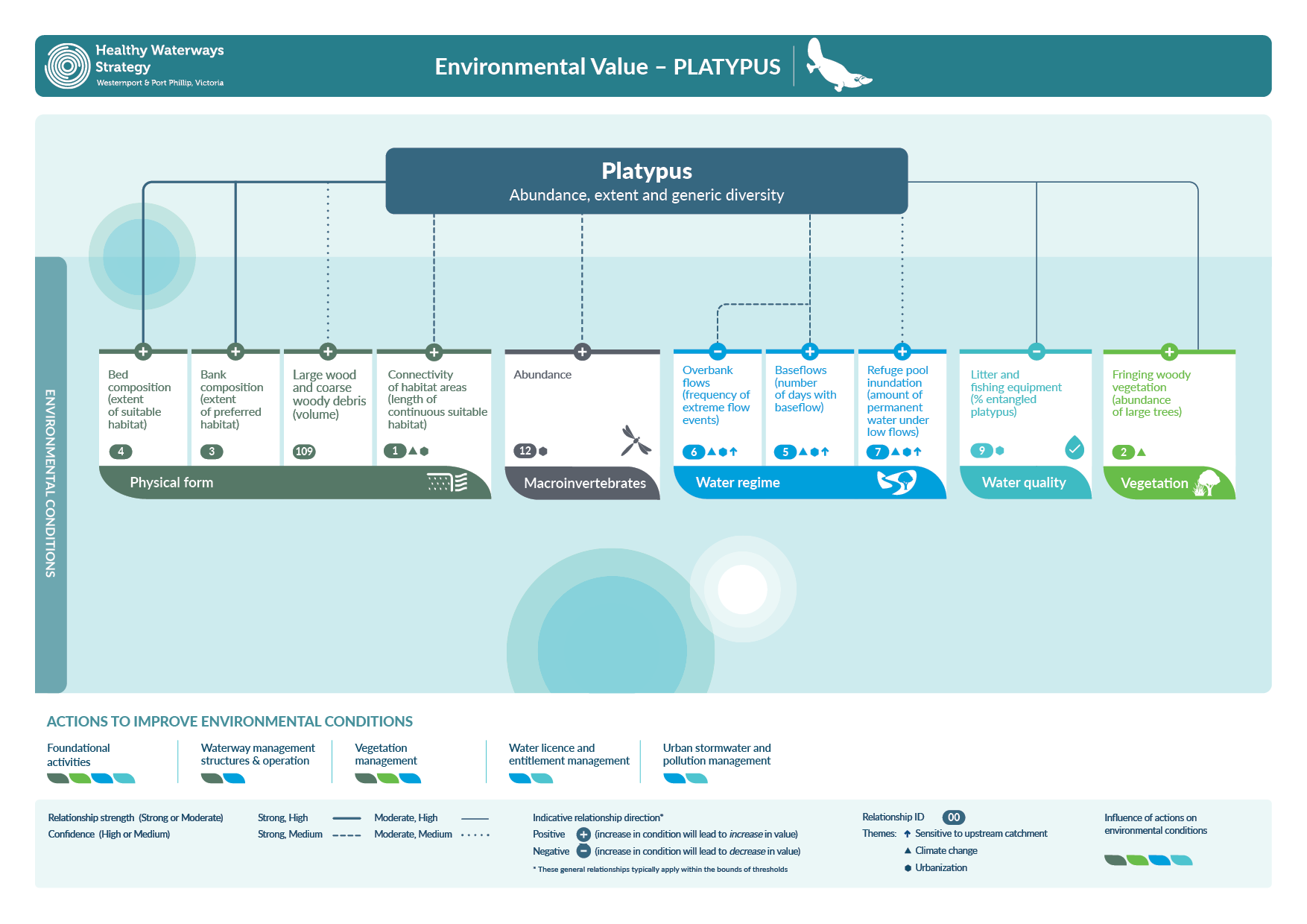
Download the platypus conceptual model (PDF 360 KB)
More information on the conceptual models can be found in the Healthy Waterways Strategy Resource Document.
Changes in waterway conditions influence platypus
The conditions that influence platypus are described below. Some of the more important ones are monitored over time so that we can track whether actions taken in the strategy are leading to improvement.
Physical form
Platypus need stable banks to allow them to build burrows. Unstable banks can easily erode and deposit sediment into rivers which impacts on macroinvertebrates and means there is less food available for platypus. Platypus also need habitat complexity - a mix of cobbles, large woody debris, pools and riffles to support habitat for food.
Connectivity along waterways is also important. Instream barriers such as large weirs, dams and other infrastructure like underground pipes can isolate populations, resulting in low genetic diversity and local extinction over the long term.
Physical form is considered under the habitat condition. See waterway conditions - habitat for more details on how the physical form of waterways is monitored.
Vegetation
Large, overhanging trees and shrubs provide platypus with shelter from predators and shading which regulates water temperature. Streamside vegetation provides bank stability for constructing burrows and reducing sediment inputs into rivers. Vegetation also provides organic matter and a supply of large woody debris to make a complex habitat for platypus.
See waterway conditions - vegetation for more details on how vegetation condition is monitored.
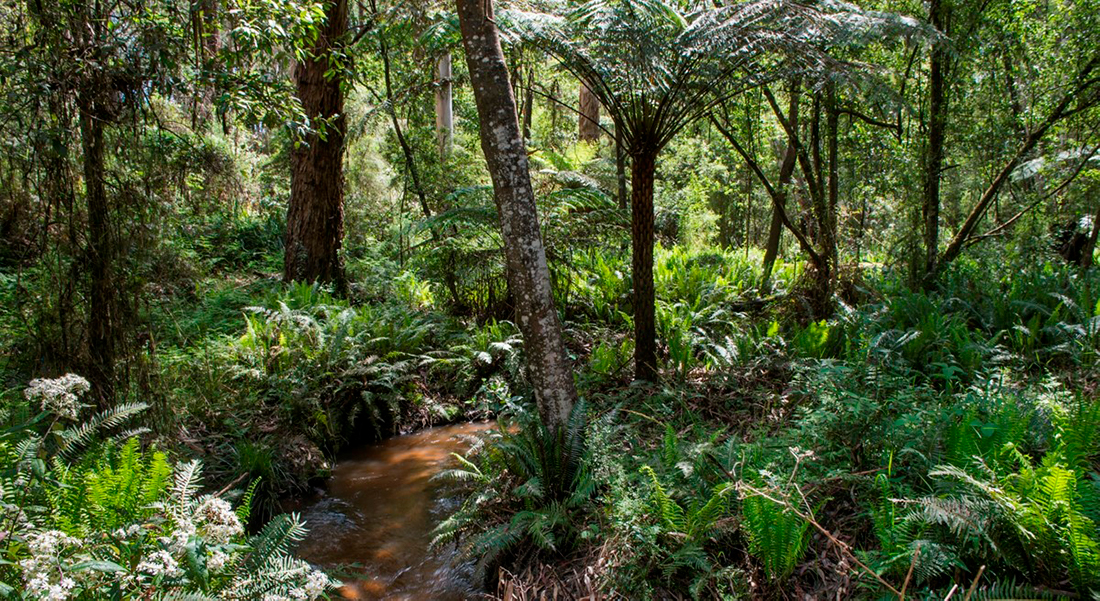
Water regime
Platypus need permanent water refuges to live and forage in, particularly in times of low flow or drought. Platypus will often forage over long distances, so higher flows provide opportunities to connect with different areas of rivers, billabongs and lakes. However, flows that are particularly large or ‘flashy’ can make it hard for platypus to swim and even displace, injure, or kill them. Increased urbanisation leads to these shorter, but more intense flows during storm events.
See waterway conditions - water for the environment and stormwater for more details on how the water regime condition is monitored.
Water quality
While platypus themselves are relatively insensitive to poor water quality, they are still impacted through food availability. Macroinvertebrates, their main food source, are sensitive to poor water quality, urban stormwater and pollution. Litter and illegal fishing equipment can kill or harm platypus through entanglement or ingestion.
See waterway conditions - water quality for more details on how the water quality condition is monitored.
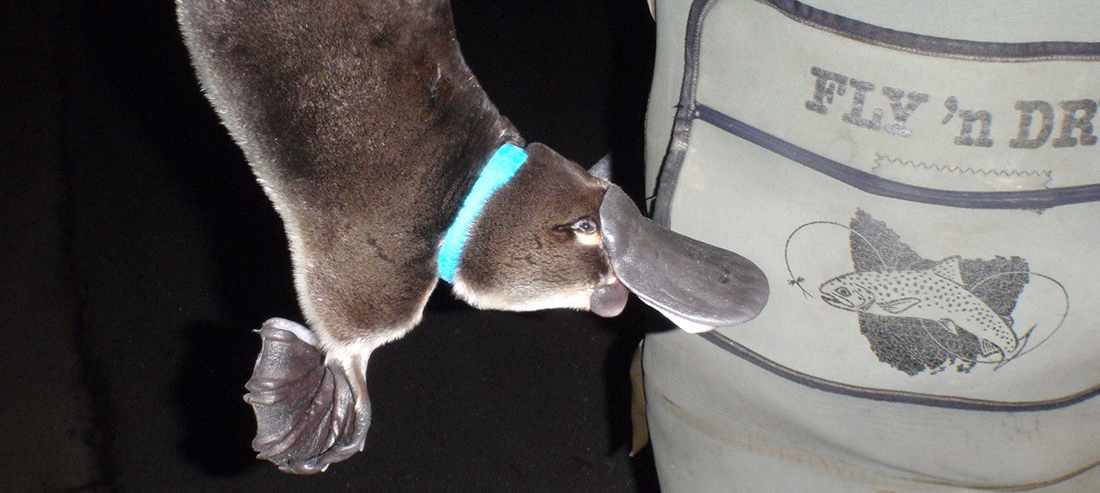
Macroinvertebrates
Platypus feed in water exclusively and rely on macroinvertebrates as their primary food source and they are known to forage for 10-12 hours per day. A lactating female may need to consume 80% of her own bodyweight per day in order to support young. Most environmental impacts on platypus are indirect through the reduction in macroinvertebrate food supply. Conditions that promote high abundance and diversity of macroinvertebrates also support platypus.
See key value - macroinvertebrates for more details on how this value is monitored.
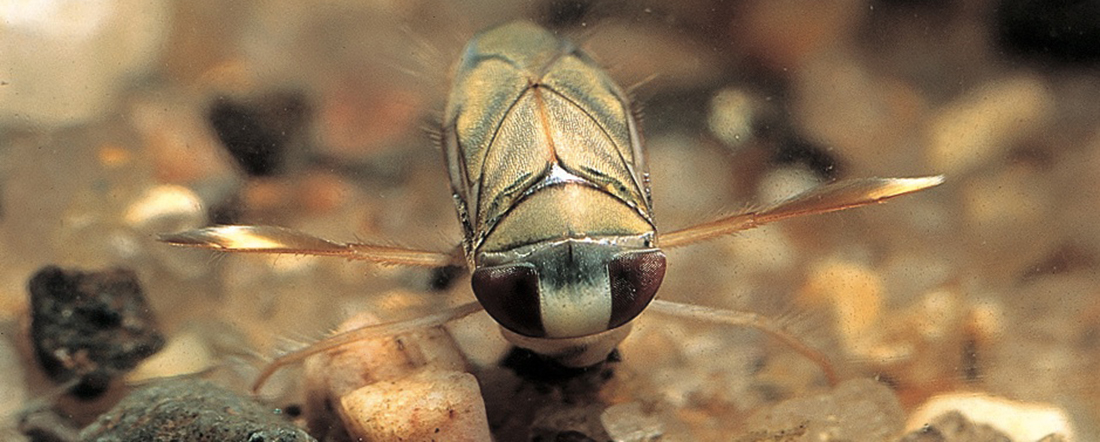
Actions that improve the condition of waterways for platypus
There are a range of actions that can improve the health of platypus. More information on how the strategy progress is being tracked can be found in the Report Card.
Mitigating threats to physical form (habitat)
Improving habitat conditions for platypus includes addressing threats to physical form such as erosion hot spots and protecting and improving instream complexity. This can include targeting works to install rocks in stream beds and banks to reduce erosion hot-spots. It can also involve managing rivers to ensure a wide range of physical forms such as riffles and pools are present.
In the Strategy, actions such as identifying and mitigating important areas of erosion will protect physical form.
Establish buffers and maintain vegetation quality
Protecting existing high value vegetation and establishing continuous vegetation buffers along priority river reaches supports platypus. Protecting mature trees and overhanging branches is especially important to provide bank stability, large woody debris inputs, shading and shelter from predators.
In the Strategy, actions such as providing grants to private and public land holders for fencing and revegetation works in priority areas will improve vegetation condition for platypus over time.
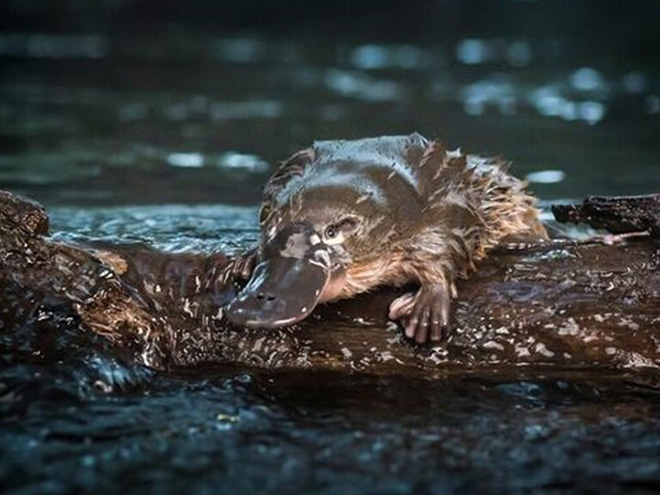
2023 Case study: Planting 4 Platypus
Platypus in the Diamond Creek in Melbourne’s north east are feeling the love from their local community who are working hard to improve the creek habitat.
Improve water for the environment
Improving the water regime for platypus populations involves securing water entitlements in regulated systems to deliver environmental flow requirements. This is particularly important for refuge reaches that are critical for platypus during drought. In unregulated systems, improving the water regime involves maintaining or improving flow conditions to support the needs of environmental values.
In the Strategy, actions such as Integrated Water Management projects that provide substitute water for irrigation, the revision of the Central and Gippsland Sustainable Water Strategy (SWS) and improving low flows in unregulated waterways will support this value.
Improve water quality
Water quality conditions indirectly impact platypus through their main food source, macroinvertebrates. Action undertaken to improve water quality such as improvements to agricultural land management to reduce pesticide, fertiliser and sediment run-off to waterways and managing sewage treatment plant discharges will all improve conditions for macroinvertebrates which will in turn support platypus.
In the strategy, actions such as improving rural land management in priority areas and maintaining sewage treatment plant discharges will help to improve water quality for macroinvertebrates and therefore platypus. Reducing litter entering waterways and the use of illegal fishing equipment supports platypus. This can be done through raised community awareness and knowledge, infrastructure, and enforcement. Assessing the volume and source of litter also helps to inform these litter reduction programs.

2023 Case study: Collaboration is key — Tackling the tricky issue of litter together
Litter in waterways continues to be of great importance for our community. Not only is it unsightly and can entangle animals, it represents the impact that invisible pollutants in run-off can have on waterways.
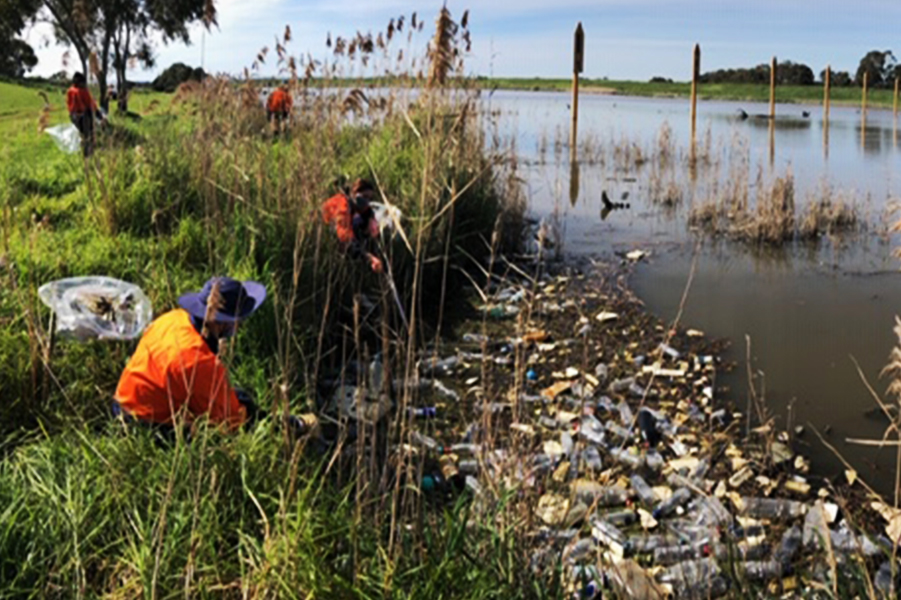
2020 Case study: Litter Trackers - Understanding litter transport in Melbourne’s waterways
Litter is a significant problem in waterways and most of the sources of litter arise from our suburban streets. Litter tracking studies using plastic bottles with small GPS tracking devices inside collected data to show how far and how quickly litter travels through drains and waterways to the sea.
Infiltrate and harvest stormwater
Reducing the direct connection of hard surfaces such as roads and roofs to traditional stormwater pipes that drain water directly to rivers is a key action to protect macroinvertebrates and therefore platypus. This is particularly important in priority areas where urban growth is occurring. Harvesting stormwater for alternative uses such as irrigation is critical. Additionally, some stormwater should be infiltrated into the soil e.g. through porous paving so that it slowly moves into the river and supports base-flow conditions.
The Strategy contains a raft of actions from updating policy, building capacity to undertaking projects to harvest and infiltrate stormwater.
Improve macroinvertebrate conditions
As their main food source, improving conditions for macroinvertebrates also supports platypus. These actions include improving water quality, water regime, habitat and vegetation.
Find out more about macroinvertebrates
Engage communities
Supporting community groups and citizen science programs to promote the value of species such as platypus improves waterway literacy and increases participation in activities that protect waterways.
In the Strategy, actions such as increasing participation in monitoring programs such as PlatypusSPOT and Waterwatch improves awareness and public support for other actions to protect and improve platypus.
